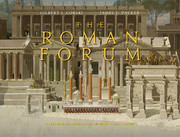Book contents
- Frontmatter
- Map
- Contents
- Preface
- Acknowledgments
- Part I. Architecture in the Roman Forum during the Empire: A Brief History
- 1 The Augustan Reconstruction (31 BCE–14 CE)
- 2 From Tiberius to Phocas (14–608 CE)
- Part II. The Monuments
- Part III. Conclusions
- Glossary
- Notes
- Bibliography
- Sources for Coin Images from the Internet and for Other Images
- Index
2 - From Tiberius to Phocas (14–608 CE)
from Part I. - Architecture in the Roman Forum during the Empire: A Brief History
Published online by Cambridge University Press: 05 March 2015
- Frontmatter
- Map
- Contents
- Preface
- Acknowledgments
- Part I. Architecture in the Roman Forum during the Empire: A Brief History
- 1 The Augustan Reconstruction (31 BCE–14 CE)
- 2 From Tiberius to Phocas (14–608 CE)
- Part II. The Monuments
- Part III. Conclusions
- Glossary
- Notes
- Bibliography
- Sources for Coin Images from the Internet and for Other Images
- Index
Summary
Tiberius (14–37 CE)
After Augustus’ death in 14, to commemorate the recovery of the military standards lost in Germany by the hapless Varus, Tiberius erected his own modestly proportioned arch (after 17). Tiberius’ architect(s) modeled its high rectangular form and general elevation after the center wing of Augustus’ Parthian Arch, which, standing across the west end of the south branch of the Via Sacra (Figs. 0.3, 1.2, 19.1), Tiberius’ monument faced (Figs. 0.1, 4, 1.3, 15.1, Gatefold 1). That location and its elevation showed the close conceptual relationship between the two. With their close proximity, one after the other, the arches, the facades of the Basilica Julia, and the Temple of Castor clearly emphasized the south block of the narrow Via Sacra (Figs. 0.1, 1.2, 18.1) as a well-defined border for the Forum. By decisively terminating the procession of monuments aligned with the Rostra, Tiberius’ Arch thus gave the Forum a new west end.
The Flavians (69–96)
The great fire of the reign of Nero burned across the east end of the Forum in 64. It destroyed the Temple of Vesta, but left the rest of the Forum untouched. By the end of his reign in 68, Nero had begun reconstructing the temple (Fig. 20.2), and by 73 Vespasian had completed the work (Figs. 2.1, 20.3). Thereafter, the slightly enlarged structure had a standard Corinthian order (Figs. 2.1, 20.2–3). Occupied with imperial reform and construction projects throughout the city after the Neronian fire, Vespasian made no further changes in the Forum, but his sons, Titus and Domitian, added three striking new monuments. Since they had no connection with the major fire of 80 (which destroyed large parts of the Campus Martius and the Temple of Jupiter Optimus Maximus on the Capitoline Hill), all three, set down in a public space traditionally associated with the Senate, prominently displayed to the Senate and people the exalted imperial status of the new emperor and his family.
- Type
- Chapter
- Information
- The Roman ForumA Reconstruction and Architectural Guide, pp. 37 - 64Publisher: Cambridge University PressPrint publication year: 2015



